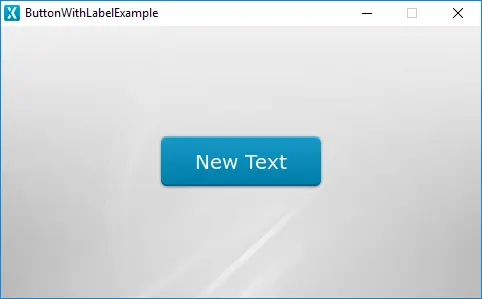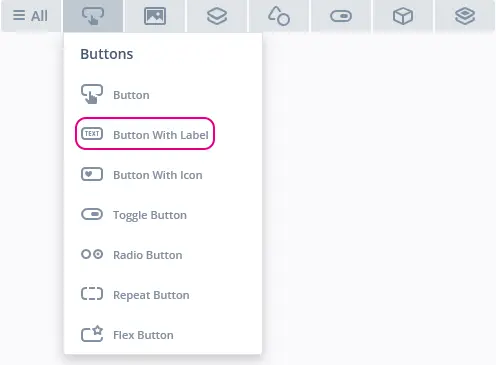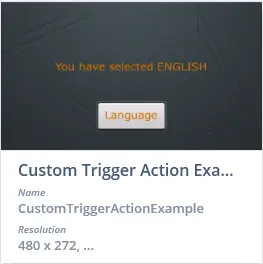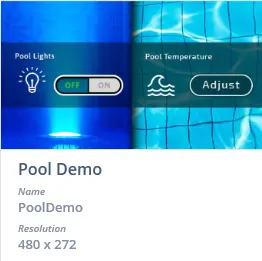Button With Label
A Button With Label in TouchGFX is a widget that is aware of touch events and can send a callback when the Button With Label is released. Each state, pressed and released, is associated with an image and a text.
The Button With Label can be replicated with the Flex Button. A Flex Button is a more configurable button that takes up a bit more RAM in exchange for flexibility.
Widget Group
The Button With Label can be found in the Buttons widget group in TouchGFX Designer.
Properties
The properties for the Button With Label are described in the following sections.
| Property Group | Property Descriptions |
|---|---|
| Name | Name of the widget. Name is the unique identifier used in TouchGFX Designer and code. |
| Location | X and Y specify the top left corner of the widget relative to its parent. W and H specify the width and height of the widget. The size of a Button With Label is determined by the size of the selected images. Lock specifies if the widget should be locked in its current X, Y, W and H. Locking the widget also disables interacting with the widget through the screen. Visible specifies the visibility of the widget. Making the widget invisible also disables interacting with the widget through the screen. |
| Text | ID specifies the text that is used. If the widget uses an auto-generated text, the ID will display 'Auto-generated'. Translation specifies the content of the text to be displayed. Typography specifies the format of the text. Alignment specifies the horizontal alignment of the text. For more details on text configuration, refer to the Using texts and fonts section. |
| Text Appearance | Released Color and Pressed Color specify the color of the Text in the pressed and released states. Alpha specifies the transparency of the widget. The alpha value ranges between 0 and 255 for the widget. 0 is fully transparent and 255 is solid. Text Rotation specifies the angle in degrees of rotation of the text. There are four possible angles : 0, 90, 80 and 270 degrees. |
| Style | Style specifies a predefined setup of the widget, that sets select properties to predefined values. These styles contain images that are free to use. |
| Image | Released Image and Pressed Image specify the images assigned to the pressed and released states from TouchGFX Designer skin library or the Project folder. |
| Mixins | Draggable specifies if the widget is draggable at runtime. ClickListener specifies if the widget emits a callback when clicked. FadeAnimator specifies if the widget can animate changes to its Alpha value. MoveAnimator specifies if the widget can animate changes to X and Y values. |
Interactions
The actions and triggers supported by the Button With Label are described in the following sections.
Actions
| Specific widget action | Description |
|---|---|
| Change button label colors | Change the color of the label. |
| Standard widget action | Description |
|---|---|
| Move widget | Move a widget to a new position over time. |
| Fade widget | Modify alpha value of widget over time. |
| Hide widget | Hides a widget (sets visibility to false). |
| Show widget | Make a hidden widget visible (sets visibility to true). |
Triggers
| Trigger | Description |
|---|---|
| Button is clicked | A Button With Label has been clicked. |
Performance
A Button With Label is composed of two images and text, and is dependent on image and text drawing. Text drawing is very similar to general image drawing (though due to the nature of text characters, a significant amount of alpha blending takes place). Therefore, the Button With Label is considered a fast widget on most platforms.
For more details on text drawing performance, read the General UI Component Performance section.
Examples
Generated Code
In the generated code for the View base class we can see how TouchGFX Designer sets up a Button With Label.
Screen1ViewBase.cpp
#include <gui_generated/screen1_screen/Screen1ViewBase.hpp>
#include "BitmapDatabase.hpp"
#include <texts/TextKeysAndLanguages.hpp>
#include <touchgfx/Color.hpp>
Screen1ViewBase::Screen1ViewBase() :
buttonCallback(this, &Screen1ViewBase::buttonCallbackHandler)
{
buttonWithLabelName.setXY(155, 106);
buttonWithLabelName.setBitmaps(touchgfx::Bitmap(BITMAP_BLUE_BUTTONS_ROUND_EDGE_SMALL_ID), touchgfx::Bitmap(BITMAP_BLUE_BUTTONS_ROUND_EDGE_SMALL_PRESSED_ID));
buttonWithLabelName.setLabelText(touchgfx::TypedText(T_SINGLEUSEID1));
buttonWithLabelName.setLabelColor(touchgfx::Color::getColorFromRGB(255, 255, 255));
buttonWithLabelName.setLabelColorPressed(touchgfx::Color::getColorFromRGB(255, 255, 255));
buttonWithLabelName.setLabelRotation(TEXT_ROTATE_0);
buttonWithLabelName.setAction(buttonCallback);
add(buttonWithLabelName);
}
void Screen1ViewBase::buttonCallbackHandler(const touchgfx::AbstractButton& src)
{
if (&src == &buttonWithLabelName)
{
//InteractionName
//When buttonName clicked calls the new virtual function "functionName()" set by the user
functionName();
}
}
Tip
buttonWithLabelName.invalidate() if you change the appearance of the widget.TouchGFX Designer Examples
To further explore the Button With Label, try creating a new application within TouchGFX Designer with the following UI templates:



